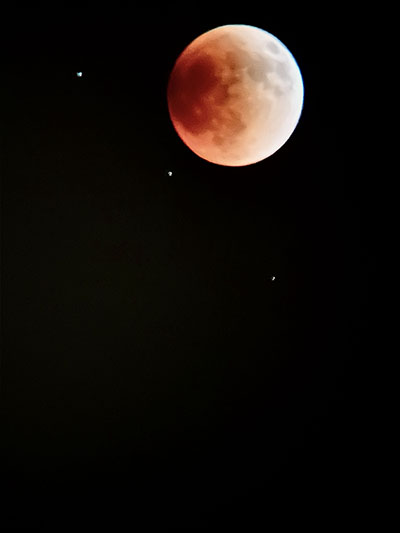SVP HR/compliance Molly Schissler took this photo of Sunday night’s “blood moon” full lunar eclipse.
 A lunar eclipse takes place when the Earth’s orbit places it between the sun and what would normally be a full moon, blocking almost all of the sun’s light from illuminating our natural satellite. As Space.com explains, some sunlight sneaks around the edges of the Earth and falls on the moon. The scattering of this light means that primarily longer — and therefore redder — wavelengths of light are what make it through, giving the blood moon its distinctive hue. (The same scattering phenomenon is responsible for the red light that dominates sunrises and sunsets.) Air pollution and clouds can affect the color as well.
A lunar eclipse takes place when the Earth’s orbit places it between the sun and what would normally be a full moon, blocking almost all of the sun’s light from illuminating our natural satellite. As Space.com explains, some sunlight sneaks around the edges of the Earth and falls on the moon. The scattering of this light means that primarily longer — and therefore redder — wavelengths of light are what make it through, giving the blood moon its distinctive hue. (The same scattering phenomenon is responsible for the red light that dominates sunrises and sunsets.) Air pollution and clouds can affect the color as well.
This eclipse also took place during a “super moon” — meaning when the moon was at the closest point to Earth in its orbit, making it look larger than usual.
“I took this picture Sunday night from our living room windows using my iPhone and a pair of binoculars,” Molly said. “Wish I had gotten better info on the three stars I picked up in the photo! The only one I know is the bright star to the left of the moon, which is part of the Libra constellation.”
This eclipse was visible from North and South America, Europe, and Africa. The next blood moon will occur on Tuesday, November 8, and will be visible from the Americas, Asia, and Australia. After that, we won’t see a blood moon again until March 2025 — only regular lunar eclipses.
